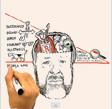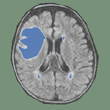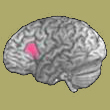Friday, 15 November 2013
Language as a Window into Human Nature

In previous posts in this blog, we have drawn your attention to various lectures in the RSA Animate series, in which experts is a variety of fields give online talks while cartoon illustrations are drawn in sped-up fashion to accompany their voice-over. This week we’d like to tell you about another RSA Animate lecture. This one is about language, and it is given by Harvard cognitive psychologist Steven Pinker. (more…)
From Thought to Language | Comments Closed
Monday, 24 June 2013
The Complementarity of the Brain’s Two Hemispheres
 Einstein said that intuition is a gift, and rationality is its servant. But in another RSA Animate lecture to which we provide a link this week, about the specialization of the two hemispheres of the human brain, psychiatrist and author Iain McGilchrist says that we have created a society that honours the servant but has forgotten the gift. (more…)
Einstein said that intuition is a gift, and rationality is its servant. But in another RSA Animate lecture to which we provide a link this week, about the specialization of the two hemispheres of the human brain, psychiatrist and author Iain McGilchrist says that we have created a society that honours the servant but has forgotten the gift. (more…)
From Thought to Language | Comments Closed
Monday, 31 December 2012
Speaking Without Broca’s Area

From Dr. Paul Broca’s observations in the 1860s, we know that the left inferior frontal cortex of the brain, now also known as Broca’s area, is heavily involved in human language abilities. At first, this area was thought to be associated only with the production of language, but gradually its role has come to be regarded as more complex, and recent brain-imaging data have actually made the old dichotomy between language-production areas and language-understanding areas somewhat obsolete. (more…)
From Thought to Language | Comments Closed
Monday, 2 July 2012
Rethinking the Role of Broca’s Area in Language
 In 1861, Paul Broca observed a sizable lesion in the left inferior frontal cortex of a patient who had just died. This individual had been able to understand what was said to him, but had been unable to pronounce anything but the syllable “tan”. Subsequently, this same observation was confirmed in many other individuals, and Broca’s area, whose destruction results in this form of aphasia (now known as Broca’s aphasia), thus became associated with the production of language.
In 1861, Paul Broca observed a sizable lesion in the left inferior frontal cortex of a patient who had just died. This individual had been able to understand what was said to him, but had been unable to pronounce anything but the syllable “tan”. Subsequently, this same observation was confirmed in many other individuals, and Broca’s area, whose destruction results in this form of aphasia (now known as Broca’s aphasia), thus became associated with the production of language.
But the role attributed to Broca’s area has become far more complex since these initial observations were made. In addition to the production of language, this area is now also believed to be involved in certain semantic aspects of language. For example, Dr. Peter Hagoort’s research using brain imaging shows that the dynamic association of Broca’s area with the left posterior temporal cortex is necessary for understanding language. (more…)
From Thought to Language | 1 comment







